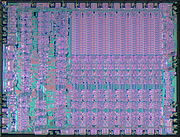RCA 1802
RCA began development of the CMOS version of the processor design in 1973, sampling it in 1974 with plans to move to a single-chip implementation immediately.Joseph Weisbecker had long been fascinated with the potential for computers in the home, having stated as early as 1955 that he expected they would one day be built into practically every device.The technology of the era made small embedded computers impossible, but the introduction of the integrated circuit (IC) in the 1960s changed things dramatically.[8]Beginning in 1970,[a] Weisbecker began the design of a small machine using RCA transistor-transistor logic (TTL) ICs to construct the processor.[1] The result, which he called FRED, ostensibly for Flexible Recreational Educational Device, was packaged into a box that was not unlike the Altair 8800 of a few years later, with toggle switches on the front panel for input, lamps for output, and later adding a hex pad keyboard.[9] Weisbecker added new features continually and by 1972 it had gained a character generator and the ability to load and save programs on cassette tapes.Robert was more interested in building the media side of the company while dating recording stars, ignoring RCA Laboratories in spite of a number of industry-leading developments taking place there.Some of the skepticism displayed by management may have had to do with the company's recent sale of their mainframe computer business to Sperry Rand with a huge writedown.While they debated, further development led to a simplified machine combining the ELF with a new display driver chip, the CDP1861, to produce a game console.[9] After a year of discussion, the company eventually decided to release two mass-market products based on the platform, a kit computer known as the COSMAC VIP, and a game console known as the RCA Studio II.Ironically, COSMAC would ultimately find great success in the embedded market, because its CMOS design allowed it to work at lower power.[9] A number of early microcomputers were based on the 1802, including the COSMAC ELF (1976), Netronics ELF II, Quest SuperELF, COSMAC VIP, Comx-35, Finnish Telmac 1800, Telmac TMC-600 and Oscom Nano, Yugoslav Pecom 32 and 64, and the CyberVision 2001 systems sold through Montgomery Ward in the late 1970s,[13] as well as the RCA Studio II video game console (one of the first consoles to use bitmapped graphics).[14] Infinite Incorporated produced an 1802-based, S-100 bus expandable console computer trainer in the late 1970s called the UC1800, available assembled or in kit form.[23] A high-speed version of the 1802 was fabricated in Silicon on Sapphire (SOS) semiconductor process technology, which gives it a degree of resistance to radiation and electrostatic discharge (ESD).[24] A different radiation-hardened version of the 1802, developed jointly by RCA and Sandia National Laboratories, was built on bulk silicon using C2L (Closed COS/MOS Logic) technology.Other available programming languages, both interpreters and compilers, are CHIP-8 (also invented by Joseph Weisbecker) (and variants), 8th (a version of Forth created by Lee Hart),[33] Tom Pittman's Tiny BASIC,[34] C, various Assemblers and cross-assemblers, and others.Interpreter for Process Structures (IPS), a programming language and development environment, was specifically written and used for real-time control of AMSAT satellites.[40] An online simulator of the COSMAC Elf (enhanced) written in JavaScript runs in the user's browser with no need to download.These were somewhat standardized between the various source suppliers, including RCA, Intersil, Harris, Hughes Aircraft, and Solid State Scientific (SSS).The 16-register design makes possible some interesting subroutine call and return mechanisms, though they are better suited to small programs than general purpose coding.(the processor always increments the PC after reference and usage (retrieving the next instruction to execute), so this technique works as noted) An interesting variation of this scheme is to have two or more subroutines in a ring so that they are called in round robin order.External hardware could read or write data during these periods without interrupting the processor, a general concept known as cycle stealing.This was used by the COSMAC Elf microcomputer and its successors to load a program from toggle switches or a hexadecimal keypad with no required software and minimal hardware.In early 1802-based microcomputers, the companion graphics Video Display Controller chip, RCA CDP1861 (for the NTSC video format, CDP1864 variant for PAL), used the built-in DMA controller to display black and white bitmapped graphics on standard TV screens at up to 64 pixels horizontally by 128 pixels vertically.The COSMAC VIP, which integrated the video chip with the processor as a single purpose-built computer (rather than as an add-on to a hobbyist kit), notably ran the 1802 much slower, synchronising it exactly with the 1861 - at a non-standard 1.76064 MHz, as recommended in the Pixie's spec sheet reference design.This information should make the routine more understandable to any computer programmer who is knowledgeable enough to read "pseudo-code" and is minimally familiar with assembly and machine language programming.Minor parts of this article were originally based on material from the Free On-line Dictionary of Computing, which is licensed under the GFDL.



microprocessorhome computerJoseph Weisbeckerstatic logicradiation hardenedRenesasIntersildual in-line packageintegrated circuittransistor-transistor logicRadio Shackcircuit boardsAltair 8800hex padcharacter generatorcassette tapesJoyce Weisbeckergame consoleROM cartridgeDavid SarnoffRobert SarnoffRCA LaboratoriesmainframeSperry Randwritedownsilicon-on-sapphirearcade gameCOSMAC ELFPopular Electronicsread only memorydirect memory accessdisplay driverCDP1861videogamesRandom HouseCOSMAC VIPRCA Studio IIFairchild Channel FAtari 2600embedded processorMOS 6502Intel 8080Zilog Z80Galileo probeJupiterELF IIComx-35Telmac 1800Telmac TMC-600YugoslavPecom 32CyberVision 2001Montgomery Wardvideo game consolebitmappedsingle-board computerretrocomputingSilicon on Sapphireresistance to radiationelectrostatic dischargeSandia National LaboratoriesGalileo spacecraftMagellanHubble Space TelescopeCHIP-8Tiny BASICmicrocontrollerspinoutstatic coreclock frequencydata busaddress businstructionsinput/outputprogram counterindex registercassetteRS-232cycle stealingClock cycleMOS Technology 6502graphicsVideo Display ControllerRCA CDP1861Pecom 64overclockFree On-line Dictionary of Computing